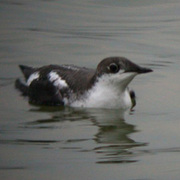Long-billed Murrelet
Brachyramphus
perdix
Charadriiformes
This is a large and highly varied group of birds that do not have many outward similarities. Most are water birds that feed on invertebrates or small aquatic creatures. The order is well represented in Washington, with seven families:
Alcidae
Alcids are diving seabirds of the Northern Hemisphere. Most are more comfortable in and under the water than in the air. While some members of the family fly long distances in post-breeding dispersal or migration, others fly only with effort. Underwater, they use their wings as flippers to swim after fish, krill, and other aquatic prey. The majority nest in colonies on islands, and many are active in these colonies only at night, spending the day foraging on open water far from their nesting sites. Many nest in burrows, and most species lay only one egg each year, although some lay two. Both sexes incubate and care for the young. Most alcids are predominantly black-and-white, with different breeding and non-breeding plumages.
General Description
Recently split from Marbled Murrelet. Five accepted records: four from the coast (three in August, one in November,)and one from the southeastern interior part of the state (in August.)
Family Members
 Common MurreUria aalge
Common MurreUria aalge Thick-billed MurreUria lomvia
Thick-billed MurreUria lomvia Pigeon GuillemotCepphus columba
Pigeon GuillemotCepphus columba Long-billed MurreletBrachyramphus perdix
Long-billed MurreletBrachyramphus perdix Marbled MurreletBrachyramphus marmoratus
Marbled MurreletBrachyramphus marmoratus Kittlitz's MurreletBrachyramphus brevirostris
Kittlitz's MurreletBrachyramphus brevirostris Xantus's MurreletSynthliboramphus hypoleucus
Xantus's MurreletSynthliboramphus hypoleucus Ancient MurreletSynthliboramphus antiquus
Ancient MurreletSynthliboramphus antiquus Cassin's AukletPtychoramphus aleuticus
Cassin's AukletPtychoramphus aleuticus Parakeet AukletAethia psittacula
Parakeet AukletAethia psittacula Whiskered AukletAethia pygmaea
Whiskered AukletAethia pygmaea Rhinoceros AukletCerorhinca monocerata
Rhinoceros AukletCerorhinca monocerata Horned PuffinFratercula corniculata
Horned PuffinFratercula corniculata Tufted PuffinFratercula cirrhata
Tufted PuffinFratercula cirrhata

